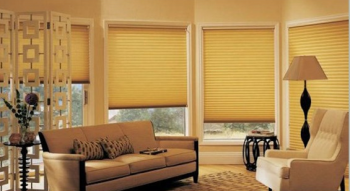Energy-efficient window coverings help reduce heating and cooling costs.

Energy Efficient Hunter Douglas Duette Architella Honeycomb Shades
Many of today’s window coverings are more than pretty—the shades, shutters, blinds, and films currently on the market offer homeowners a variety of sunning and shading options that make a room look nice while giving your heating and cooling bills an extremely green makeover.
Many energy-efficient window coverings have insulating values of R-2 to R-4, effectively doubling the insulating value of a standard, premium vinyl window with double-pane glass and a low E coating. An average house featuring 15 windows outfitted with energy-efficient window coverings can achieve an annual energy savings of $150-$300 annually
Honeycomb shades
If you’d like to combine privacy and energy efficiency, honeycomb shades are a good choice. These shades feature a layered design that traps air in individual cells. Because inert air is a poor conductor of heat, a honeycomb shade creates an effective temperature-transfer barrier between the window and the room.
The main drawback to most honeycombs and other energy-efficient shade systems is that when the shades are down and insulating your house, they’re also blocking light and preventing you from seeing out. One solution is to purchase translucent shades that let light in. But if you go that route and turn on interior lights at night, the whole world will see the inside of your home as if you had no shades at all. If you go this route, consider using drapes to provide privacy when interior lights are on.
Plantation shutters
Plantation shutters are fitted to the interior side of a window, and usually are chosen for their aesthetic appeal. However, plantation shutters are also energy-efficient. Shutters offer R-values between 2.77 and 3.17.
Both wood and vinyl plantation shutters act as effective insulators, although wood is slightly better at resisting temperature conductivity. Because the shutters fit tightly in window frames, they also block the transfer of heat through air movement or convection, creating a barrier between outside temperatures and your home’s interior.
Draperies
Homeowners usually think about drapes as interior decor statements. But the flowing fabric is a great option when you’re looking to up your energy-efficiency quotient.
Look for drapes with lining and interlining—blackout lining protects from summer sun and heat, while thermally lined drapes (which have interlining made of thick flannel or other heavy material) shut out the cold. Homeowners in climates that don’t often dip below freezing can skip the interlining and save a bit of money, since the drapes and lining alone should insulate effectively.
Like shades and shutters, draperies are only efficient when they’re closed. However, if they’re used in conjunction with another window covering, such as a honeycomb shade or a wood blind, you can let sun in during daylight hours and effectively shut out colder air at night. When fully closed, the R-values of thermally lined drapes range from R-3 to R-5, depending on the type of fabric and the thickness of the lining and interlining.
To maximize energy efficiency, we recommend floor-to-ceiling drapes that fold back against the wall. This allows the drapes to seal off the window, preventing drafts and loss of heat through convection.

